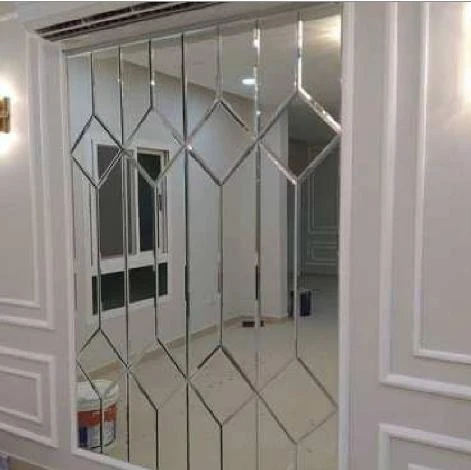Understanding Aluminum Mirror Reflectivity A Key Element in Optics and Engineering
In the world of optics and engineering, the choice of materials plays a crucial role in determining the effectiveness of various devices. One of the most widely used materials is aluminum, particularly valued for its unique reflective properties. The reflectivity of aluminum mirrors has made them indispensable in a myriad of applications, ranging from telescopes and lasers to architectural design and solar energy systems. This article delves into the science of aluminum mirror reflectivity, exploring how it is measured, its advantages and disadvantages, and its various applications.
The Physics of Reflectivity
Reflectivity refers to the ability of a surface to reflect incident light. It is expressed as a percentage, with 100% representing perfect reflection and 0% representing no reflection at all. The reflectivity of materials like aluminum can be influenced by various factors, including surface finish, thickness, and wavelength of the incident light. For aluminum mirrors, the average reflectivity is around 90% for visible light, though this can vary with different surface treatments.
The most common form of aluminum used in optics is a thin layer deposited onto substrates like glass or plastic. This layering process enhances the mirror's overall performance. The typical thickness of this aluminum coating is controlled to optimize reflectivity and minimize absorption, ensuring that as much light as possible is reflected back.
Advantages of Aluminum Mirrors
Aluminum mirrors come with several advantages. Firstly, their high reflectivity in the visible light spectrum makes them ideal for applications requiring precise light manipulation. They are particularly effective in environments where cost-efficiency is prioritized, as aluminum is less expensive than many high-performance alternatives like silver or gold.
Secondly, aluminum mirrors exhibit good durability and resistance to environmental factors such as moisture and temperature changes. This makes them suitable for outdoor applications, such as in solar panels or outdoor lighting installations. Their lightweight nature also contributes to easier handling and installation, particularly in large-scale projects.
Moreover, aluminum can be easily treated with protective coatings that enhance its reflective properties while further increasing its durability. These coatings can also prevent oxidation, a common issue that reduces reflectivity over time, thereby extending the lifespan of aluminum mirrors.
aluminum mirror reflectivity
Disadvantages of Aluminum Mirrors
Despite their advantages, aluminum mirrors are not without drawbacks. One of the significant limitations is their lower reflectivity compared to other materials like silver, which can achieve reflectivity levels upwards of 95%. This means that in high-precision applications, particularly in scientific research or high-end optics, aluminum may not always be the best choice.
Another consideration is the susceptibility of aluminum to oxidation. While protective coatings can mitigate this issue, over time, exposure to air and moisture can still lead to a gradual decline in performance. Consequently, regular maintenance might be required to ensure optimal reflectivity.
Applications of Aluminum Mirrors
The versatility of aluminum mirrors allows them to be used in various applications. In the field of astronomy, telescopes employ aluminum mirrors for their ability to reflect light from distant celestial objects effectively. Similarly, in industrial applications, aluminum mirrors are pivotal in laser systems where efficient light transport is critical.
In commercial realms, their use in solar energy systems is significant. Aluminum mirrors can effectively concentrate sunlight, thereby enhancing the efficiency of solar panels. Furthermore, in architecture, aluminum mirrors are increasingly used to create visually appealing spaces that also optimize natural light.
Conclusion
In summary, aluminum mirrors play a vital role in various fields due to their favorable reflectivity and durability. While they come with certain limitations, their cost-effectiveness and versatility make them a go-to choice in many applications. Understanding the science behind their reflectivity can guide engineers and designers in selecting the right materials for their projects, ultimately shaping innovations in optics and engineering. As technology advances, the ongoing refinement of aluminum mirror properties will continue to open new avenues in their application and effectiveness.
 Afrikaans
Afrikaans  Albanian
Albanian  Amharic
Amharic  Arabic
Arabic  Armenian
Armenian  Azerbaijani
Azerbaijani  Basque
Basque  Belarusian
Belarusian  Bengali
Bengali  Bosnian
Bosnian  Bulgarian
Bulgarian  Catalan
Catalan  Cebuano
Cebuano  Corsican
Corsican  Croatian
Croatian  Czech
Czech  Danish
Danish  Dutch
Dutch  English
English  Esperanto
Esperanto  Estonian
Estonian  Finnish
Finnish  French
French  Frisian
Frisian  Galician
Galician  Georgian
Georgian  German
German  Greek
Greek  Gujarati
Gujarati  Haitian Creole
Haitian Creole  hausa
hausa  hawaiian
hawaiian  Hebrew
Hebrew  Hindi
Hindi  Miao
Miao  Hungarian
Hungarian  Icelandic
Icelandic  igbo
igbo  Indonesian
Indonesian  irish
irish  Italian
Italian  Japanese
Japanese  Javanese
Javanese  Kannada
Kannada  kazakh
kazakh  Khmer
Khmer  Rwandese
Rwandese  Korean
Korean  Kurdish
Kurdish  Kyrgyz
Kyrgyz  Lao
Lao  Latin
Latin  Latvian
Latvian  Lithuanian
Lithuanian  Luxembourgish
Luxembourgish  Macedonian
Macedonian  Malgashi
Malgashi  Malay
Malay  Malayalam
Malayalam  Maltese
Maltese  Maori
Maori  Marathi
Marathi  Mongolian
Mongolian  Myanmar
Myanmar  Nepali
Nepali  Norwegian
Norwegian  Norwegian
Norwegian  Occitan
Occitan  Pashto
Pashto  Persian
Persian  Polish
Polish  Portuguese
Portuguese  Punjabi
Punjabi  Romanian
Romanian  Russian
Russian  Samoan
Samoan  Scottish Gaelic
Scottish Gaelic  Serbian
Serbian  Sesotho
Sesotho  Shona
Shona  Sindhi
Sindhi  Sinhala
Sinhala  Slovak
Slovak  Slovenian
Slovenian  Somali
Somali  Spanish
Spanish  Sundanese
Sundanese  Swahili
Swahili  Swedish
Swedish  Tagalog
Tagalog  Tajik
Tajik  Tamil
Tamil  Tatar
Tatar  Telugu
Telugu  Thai
Thai  Turkish
Turkish  Turkmen
Turkmen  Ukrainian
Ukrainian  Urdu
Urdu  Uighur
Uighur  Uzbek
Uzbek  Vietnamese
Vietnamese  Welsh
Welsh  Bantu
Bantu  Yiddish
Yiddish  Yoruba
Yoruba  Zulu
Zulu 

